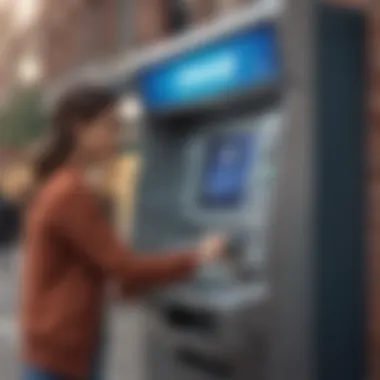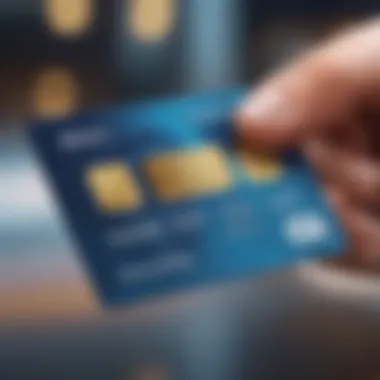Deposit Methods for Your Chase Card Explained


Intro
Managing finances nowadays is as essential as breathing to many. One crucial aspect of efficient financial management is knowing how to effectively deposit money into your Chase card. Whether it’s for day-to-day expenses or building a nest egg for that dream vacation, having a solid grip on your deposit options can simplify a lot of your banking woes.
This article will dive into the various methods Chase offers for depositing funds, from the classic brick-and-mortar bank branches to the increasingly popular mobile applications. We’ll break down the nuances of each method while pointing out fees you might encounter along the way, and touch on important security considerations as well. By the end, you’ll not only know how to deposit money but feel confident navigating your options.
Preamble
In the realm of personal finance, understanding how to effectively manage deposits on your Chase card can be a game-changer. This article seeks to shed light on this crucial topic, which many may take for granted but is often riddled with nuances. Knowing your options for depositing funds not only empowers users but also unlocks the potential to optimize cash flow and avoid unnecessary fees. With the right information at hand, individuals can maneuver through the multitude of deposit methods available and choose those that align with their lifestyle and needs.
Purpose of the Article
The main goal of this article is straightforward yet impactful: to serve as a comprehensive guide to the various deposit options for your Chase card. With a urbanite's pace of life, users often prioritize speed and convenience. However, rush sometimes begets mistakes. This narrative endeavors to present a clear path through the complexities of banking, ensuring readers can make informed decisions without the fog of confusion.
Understanding deposit methods is not merely a transactional necessity—it’s a part of being financially literate. This guide will arm users with knowledge they can trust and utilize day in, day out, helping them navigate the landscape of deposits with confidence.
Overview of Chase Card Deposits
Chase bank offers a variety of deposit options, each designed to cater to the diverse needs of their customers. Be it a quick deposit on-the-go using a mobile app or a more traditional method at a physical branch, knowing your avenues can prevent hassle and maximize efficiency.
Moreover, deposit methods come with their set of considerations—some require specific documents, while others have limits on how much you can deposit in a day. Therefore, it’s essential to grasp these facets in order to avoid potential bottlenecks.
In the sections that follow, we will delve deeper into each method, discussing not just the how-tos but also the associated fees and security considerations that should be on every user’s radar. In summary, the aim is to provide a robust understanding that helps in making each deposit count.
Understanding Your Chase Card
Grasping the concept of your Chase card is crucial for effectively navigating the world of deposits. When you know the functionalities and possibilities associated with each type of card, it becomes easier to make informed decisions regarding your finances. This article will delve into the various types of Chase cards and their common uses, enhancing your understanding and ensuring you squeeze the most out of your banking experience.
Types of Chase Cards
Understanding the different types of Chase cards can be likened to knowing the tools in a toolbox; each serves a distinct purpose and caters to unique needs.
Credit Cards
Credit cards are a slice of the financial pie that many folks enjoy. The main draw here is the ability to borrow money up to a specified limit for purchasing goods or services. With a credit card from Chase, users get a chance to earn rewards while managing their monthly spending.
A notable feature of these cards is the grace period. When you pay off your balance in full before the due date, you don’t rack up interest on your purchases. This is enticing for those who prefer to pay their dues promptly, making it a popular choice for responsible spenders. However, for someone who can't keep up with payments, credit cards can lead to hefty interest charges.
Debit Cards
Moving on to debit cards, they offer a more straightforward approach to managing your finances. With a Chase debit card, you're dealing directly with your checking account. If you want to buy something, the money comes straight out of your account, which can help keep you grounded financially.
What’s appealing about debit cards is that there’s no chance of overspending. You're only able to use what you already have, making it a wise choice for budget-conscious individuals. However, it comes with a caveat—if you need to make large purchases, you can hit a wall since there’s no line of credit here.
Prepaid Cards
Lastly, prepaid cards act like a better cousin to gift cards. You load money onto these cards before using them, allowing for controlled spendings. Chase’s prepaid options can be helpful if you're looking to manage your money meticulously or for specific projects, such as everyday spending or a trip abroad.
One standout feature is that they often come with features to load direct deposits, making it possible to receive your paycheck onto the card directly. But since they don’t build credit history, they’re not an ideal choice for someone looking to strengthen their credit score.
Common Uses of Chase Cards


Chase cards can serve a variety of purposes, depending on the type you choose and your financial goals. Here are a few common uses:
- Shopping: Whether in-store or online, having a Chase card can streamline your purchases while possibly earning rewards.
- Bill Payments: Many people utilize credit or debit cards to automate bill payments, ensuring on-time payment and sometimes gaining additional rewards.
- Travel and Entertainment: Certain Chase credit cards provide travel perks, such as points for airline miles or hotel stays, adding value to your travel plans.
Deposit Methods
When it comes to managing your finances, knowing how to deposit money into your Chase card is crucial. These deposit methods play a fundamental role in facilitating access to your funds and enabling smoother transactions. Whether you prefer the face-to-face interaction of a bank branch, the convenience of ATMs, or the modernity of mobile banking, understanding these different options can serve you well. Each method offers unique benefits and some considerations that might influence your choice depending on your specific circumstances.
Depositing at Chase Bank Branches
Depositing at a physical Chase bank branch is a classic choice. It often provides a sense of comfort for individuals who prefer human interaction during their banking tasks.
Finding a Branch
Finding a Chase branch isn’t overly complicated. The bank features a robust search tool on its website, allowing you to identify the nearest locations. Chase branches are typically dotted throughout neighborhoods, making it convenient for people to drop in during business hours. One standout characteristic of this method is the in-person assistance you can receive. Bank personnel are generally well-trained and can guide you through the deposit process or address any questions that arise.
Moreover, the availability of additional banking services, like speaking to a financial advisor or resolving complex issues, sets this method apart. However, a downside could be that it may take time—something particularly daunting during busy hours.
Documents Required for Deposit
When it comes to documents required for deposit, it's generally straightforward. You'll primarily need your Chase card and a form of identification, like a driver's license or passport. This simplicity means that depositing at a branch is often quick, making it a popular choice.
A unique feature here is that if you're depositing checks, you may need the check itself fully endorsed. Ensuring you have all required documents prevents any potential hiccups. On the flip side, forgetfulness can lead to wasted trips, emphasizing the importance of being prepared before heading out.
Using Chase ATMs for Deposits
For those who favor minimal contact and quicker transactions, using Chase ATMs can be a great option.
ATM Locations
Chase boasts extensive ATM locations, making it easy to find one wherever you are. This accessibility allows for round-the-clock deposits without the hassle of waiting for business hours at a branch. One key trait of these ATMs is their versatility; you can withdraw cash, check balances, and deposit as well, all in one go.
However, although convenient, not every ATM supports deposits, so you may need to use the ATM locator tool on the Chase website or app to ensure you're going to a suitable spot. The beauty of this method is that you can get in and out rather quickly, but the trade-off might involve missing personalized service found in branches.
Step-by-Step Deposit Process
The step-by-step deposit process at a Chase ATM is designed to be user-friendly. First, you insert your card and follow the prompts on the screen. Next, select the deposit option, and insert your cash or endorsed checks as instructed. Finally, confirm the deposit and keep your receipt for your records.
The straightforward nature of this process often appeals to those who value efficiency. However, one tricky aspect is to remember to follow the on-screen guidelines closely; any deviation could result in errors or delays, so pay attention.
Mobile Deposit Options
In this digital age, mobile deposits are booming in popularity.
Preparing for Mobile Deposit
Preparing for a mobile deposit is another game changer. First off, you’ll need to make sure you’ve downloaded the Chase mobile banking app. Once that’s done, take clear pictures of the front and back of your check or the cash envelope as instructed. The key here is light and focus; having a well-lit area with minimal shadows can significantly enhance the quality of your images.
This method is particularly beneficial as it allows you to deposit funds from virtually anywhere, saving you time and effort. But on the downside, it may take some time to familiarize yourself with the app, especially for new users.
Using the Chase Mobile App


The Chase mobile app is a cornerstone for many bank customers today. By logging into your account, the app offers a sleek interface to manage your funds, including seamless mobile deposit functionality.
One unique feature is the real-time upload of deposited funds; once your check is verified, the app shows a confirmation right away. This makes it easy to see your updated balance instantly. On the flip side, users can encounter technical glitches occasionally, which could deter from a smooth experience. Being patient and knowing how to troubleshoot minor issues can make a significant difference in your overall satisfaction.
Fees and Limits Associated with Deposits
Understanding the fees and limits associated with deposits is critical when managing your Chase card effectively. These elements can significantly impact your overall financial planning. For instance, knowing the fees allows you to avoid unexpected charges that can eventually add up. Similarly, being aware of the transaction limits helps in ensuring you don’t face issues while making deposits, especially during critical financial moments.
Chase, like many financial institutions, imposes certain fees and establishes limits on the number and amount of deposits made to your card. It’s prudent to familiarize yourself with these aspects so that you can navigate transactions while optimizing your resources.
Understanding Deposit Fees
Deposit fees are charges that may occur whenever you make a transaction to your Chase card. While many consumers expect their deposits to be free, it’s important to remember that financial institutions function on fees collected from various services. Primarily, Chase does not charge fees for standard deposits to a checking or savings account at their branches or ATMs, but there are specific scenarios where charges may apply.
For example, if you’re using another bank’s ATM for deposits, you might face fees imposed by that bank. Also, certain types of deposits may incur additional fees, depending on the account type or the nature of the transaction. Always check the terms that come with your specific Chase card or account.
Some common deposit fees to be aware of include:
- Out-of-network ATM fees: Using an ATM that isn’t part of the Chase network can result in charges, both from Chase and the owning bank.
- Currency conversion fees: If you’re making deposits in foreign currency, be mindful of possible conversion fees.
- Expedited deposit fees: Sometimes, if you need your funds cleared more quickly than usual, faster processing might come at a cost.
Daily and Monthly Deposit Limits
Alongside the knowledge of fees, it’s crucial to understand the daily and monthly deposit limits set by Chase. These limits can vary by account type and are designed to protect both the customer and the bank from fraudulent activities. Knowing these limits helps you plan your finances so you can deposit what you need without facing unnecessary hurdles.
Chase typically has a few key points regarding deposit limits:
- Regular deposit limits: Standard accounts usually have a limit of a few thousand dollars per day, but this can differ greatly among account types.
- Mobile deposit limits: When using the Chase mobile app, there are specific limits on how much you can deposit through this platform. This limit could be lower than what you'd experience at a physical branch or ATM.
- Rolling limit: It's also worth noting that some types of accounts may impose rolling limits that affect how much you can deposit cumulatively over a certain timeframe.
To summarize, understanding the fees and limits surrounding deposits not only protects your finances but also empowers you to use your Chase card more efficiently. Having a clear picture of these aspects equips you to maneuver through your banking needs without surprises.
"A stitch in time saves nine." If you’re proactive about knowing these details, it’ll save you a lot of time and trouble on your banking journey.
Security and Fraud Prevention
Ensuring the safety of deposits into your Chase card is paramount in today's digital age. The rise of online transactions and mobile banking has brought conveniences, but it has also attracted the unwarranted attention of fraudsters. Understanding the importance of security and fraud prevention is crucial for maintaining control over your finances. By being proactive and educated about potential threats, you can make your deposit experience not just efficient but also secure.
The benefits of robust security practices are manifold. First, they help protect your hard-earned money from theft. Second, they mitigate the emotional distress that comes with being a victim of fraud. Lastly, promoting a culture of security can enhance trust within financial institutions, fostering a safer banking environment for everyone involved.
When you deposit money into your Chase card, it's necessary to keep a keen eye on activities that may seem out of the ordinary. This includes checking your account statements regularly and ensuring that you know the methods and channels you use for deposits.
"Safeguarding your finances isn't just about knowing what to do; it's about having the vigilance to notice when something feels off."
Best Practices for Secure Deposits
The journey to secure deposits begins with understanding and implementing best practices. Here are several key strategies you should follow:
- Use Secure Networks: Avoid making deposits over public Wi-Fi. Always use a trusted, secure connection. If possible, enable a VPN.
- Enable Notifications: Turn on transaction alerts in the Chase app to get real-time updates on deposits and withdrawals.
- Keep Personal Information Private: Never share your personal banking details online or over the phone unless you’re sure of the recipient's identity.
- Regularly Change Your Passwords: Use a mixture of letters, numbers, and symbols to keep your online accounts safe.
- Monitor Your Accounts: Keep an eye out for unfamiliar transactions. Reporting any discrepancies is critical in resolving them quickly.
By following these practices, you create layers of protection that work to secure your financial transactions.
Recognizing Scams and Fraudulent Activities


In a world where scams are becoming increasingly sophisticated, it's essential to arm yourself with knowledge on how to recognize fraudulent activities. Being able to spot warning signs early can save you from unnecessary headaches. Here’s what to look for:
- Phishing Emails or Messages: Be wary of unsolicited emails asking for your account details, especially if they contain links that lead to unfamiliar websites.
- Urgency and Pressure Tactics: Scammers often create a sense of urgency, pressuring you to act quickly without giving it a second thought.
- Unusual Phone Calls: If someone claims to be from Chase and asks for sensitive information, hang up and call the official number back.
- Too Good to Be True Offers: If an opportunity sounds too good to be true, it likely is. Exercise extreme caution.
Staying vigilant and informed is your best line of defense. The more you recognize the signs of potential scams, the less likely you are to fall victim to them.
Troubleshooting Deposit Issues
When it comes to managing finances, occasional hiccups are par for the course. Understanding how to troubleshoot issues that may arise during the deposit process is crucial for anyone utilizing their Chase card. Addressing common problems swiftly can save time and stress, ensuring smoother transactions in the future. Ultimately, being informed equips users to take control of their financial interactions with Chase, thus avoiding potential roadblocks.
Common Issues Encountered
In the realm of deposits, certain issues tend to rear their heads more than others. Below, we break down two of the most common challenges: delayed deposits and deposit rejections.
Delayed Deposits
Delayed deposits can be especially frustrating, like waiting for a bus that never seems to show. This issue refers to instances where the funds you expect to see just aren’t there when you check your balance. Factors like processing times, bank holidays, or even simple human error can contribute to these delays.
What sets delayed deposits apart is the uncertainty they create. Users may find themselves wondering if the money was deposited successfully or if they need to take further action. For many, knowing that this is a common occurrence can bring a bit of relief. Most delayed deposits resolve within a short window, commonly within 1-2 business days.
However, the downside is that it can cause temporary inconvenience, especially if someone is counting on those funds for immediate expenses like paying bills or making purchases. Patience is key, alongside an understanding of the potential delays in processing.
Deposit Rejections
Deposit rejections can be even more disheartening because they mean your funds won’t be going anywhere. This occurs when Chase determines that a deposit cannot be accepted, often due to reasons like incorrect information, exceeding deposit limits, or issues with the source of the funds.
What makes deposit rejections particularly noteworthy is how explicitly they can undermine trust in the banking process. When rejection occurs, it’s vital to address the underlying issue to prevent it from happening again. Checking the deposited amount, ensuring compliance with limits, and verifying the accuracy of account numbers can significantly reduce the chances of future rejections.
While it might seem intimidating at first glance, understanding the reasons behind deposit rejections can prepare users to handle them more effectively. Often, a quick phone call to customer support clears up confusion and corrects any mistakes, getting the funds where they belong.
Contacting Customer Support
When troubleshooting deposit issues, there comes a time when reaching out to customer support is the best course of action. Chase offers robust support options, including a customer service phone line and online chat capabilities. This ensures that help is just a few clicks or a call away.
Tips for effective communication include having relevant information on hand, such as account numbers and details about the transaction in question. This preparation can greatly expedite assistance. Moreover, patience pays off — timers can fluctuate, so don’t be surprised if peak hours mean longer wait times.
In wrapping things up, being proactive in addressing deposit issues can make all the difference in the user experience for Chase cardholders. Equip yourself with knowledge to minimize delays and lack of funds, while also knowing how to seek help if needed.
End
In wrapping up our exploration of deposit options associated with your Chase card, it’s crucial to underscore the many pathways available to manage your finances effectively. This conclusion serves not only as a recap but also as a motivator for you to engage more confidently with your deposits. Each method outlined—from visiting branches to leveraging mobile apps—offers its unique set of benefits tailored to the diverse needs of users.
One core benefit of diversifying your deposit methods is flexibility. Whether you’re in a busy metropolis or a quiet town, having multiple ways to make deposits means you’re less likely to hit a snag. Think about it: a sudden need arises, and being able to deposit via the app on your phone can save time and hassle. This adaptability becomes even more vital if you're managing business finances or need quick access to funds.
Furthermore, understanding potential fees and limits helps ensure you’re not caught off guard. Each deposit method has its nuances, and being informed allows you to maneuver financially with a keen eye. After all, knowledge is power. Keeping abreast of security measures adds another layer of peace of mind, knowing that your transactions are safeguarded against fraud.
Additionally, recognizing common troubleshooting scenarios allows you to navigate potential bumps in the road smoothly. No one wants to be in a bind when trying to access funds or make a crucial payment. That’s why knowing the ropes can prevent small issues from becoming major headaches.
Ultimately, engaging with your deposits through the lens of the various methods discussed not only increases your financial efficiency but also fosters a deeper understanding of your banking practices, leading to more informed decisions and ultimately better money management. While every financial institution has its procedures, the more you know about how to effectively handle your deposits with Chase, the more empowered you become in your financial journey.
Summary of Key Points
- Diverse Deposit Methods: Understanding various deposit channels—branches, ATMs, and mobile—is vital for efficient cash flow management.
- Flexibility is Key: Availability of multiple deposit methods meets users in different situations, emphasizing convenience and time-saving possibilities.
- Awareness of Fees and Limits: Being aware of potential fees and deposit limits helps in planning finances effectively and avoiding unnecessary charges.
- Security Matters: Proper security practices reinforce the safety of your deposits, creating a safeguard against fraud risks.
- Troubleshooting Knowledge: Knowing how to handle common issues can save time and stress, ensuring smoother banking experiences.
Final Thoughts on Effective Depositing
Depositing money into your Chase card shouldn’t be a daunting task; rather, it should feel like a natural extension of managing your finances. By combining the insight gained throughout this article with your personal financial habits, you can turn this routine into a moment of confidence, knowing you have the tools and information at your disposal to handle your deposits efficiently.
Using the right deposit method at the right time can enhance your banking experience significantly. Evaluate your needs regularly, stay updated on any policy changes from Chase, and don’t hesitate to reach out to customer support when necessary. After all, it’s your money—make sure you’re treating it with the care and respect it deserves.



